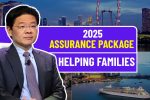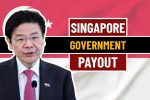
The Singapore government continues its commitment to supporting citizens through economic transitions with the 2025 Assurance Package (AP). Designed specifically to cushion the impact of the Goods and Services Tax (GST) increase, this comprehensive support program features direct cash payouts as a centerpiece benefit. As living costs rise and economic pressures mount, these targeted financial disbursements provide meaningful relief for eligible Singaporeans across different income brackets.
Overview of the 2025 Assurance Package
The Assurance Package represents a multifaceted approach to economic support, extending beyond simple cash transfers to include MediSave top-ups, Community Development Council (CDC) vouchers, and Service and Conservancy Charges (S&CC) rebates. This integrated system ensures that citizens receive assistance across multiple dimensions of household expenses.
The program spans five years (2022-2026), with carefully structured payouts designed to provide sustained support through the GST transition period. The 2025 disbursement represents a critical phase of this longer-term initiative, offering significant financial relief particularly for lower and middle-income households.
(Also Read = Monthly Financial Support of S$840 – S$900 in Singapore)
Eligibility Criteria for 2025 Cash Payouts
To qualify for the 2025 AP cash payout, citizens must meet specific requirements:
- Singapore citizenship
- Minimum age of 21 years in 2025
- Income within eligible thresholds
- Property ownership status that meets program guidelines
The government has structured a tiered benefit system based on Assessable Income (AI) levels:
- Lower Income Bracket: Citizens with AI up to $34,000 qualify for the maximum payout
- Middle Income Bracket: Those with AI between $34,001 and $100,000 receive a reduced but still substantial amount
- Higher Income Bracket: Individuals with AI exceeding $100,000 remain eligible for a minimal support payment
This graduated approach ensures that assistance is proportionate to financial need, with more substantial support directed toward those facing greater economic challenges.
Also Read =
Payment Structure and Total Benefits
The 2025 AP cash payout continues the five-year distribution plan established under the broader Assurance Package. The cumulative benefits over this period vary by income bracket:
- Lower Income Recipients (AI up to $34,000): Total of $2,250 across the five-year program
- Middle Income Recipients (AI $34,001-$100,000): Total of $1,350 over the program duration
- Higher Income Recipients (AI above $100,000): Cumulative benefit of $700
The 2025 portion of these payments begins distribution in December 2024, providing timely financial support ahead of year-end expenses and festivities.
Important Dates and Distribution Timeline
The government has established a clear schedule for the 2025 payout distribution:
- December 5, 2024: First wave of payments begins for citizens with NRIC linked to PayNow
- December 16, 2024: Standard bank transfers commence for those with updated account information (must be updated by November 27)
- December 24, 2024: GovCash payments initiated for recipients without PayNow or updated bank details
To ensure the earliest possible receipt of funds, citizens should complete PayNow linking by November 23, 2024. This simple preparatory step can expedite the payment process by up to three weeks compared to alternative disbursement methods.
Streamlined Process with Automatic Assessment
One of the most user-friendly aspects of the AP Cash Payout is its automated eligibility determination. Citizens do not need to submit applications or navigate complex paperwork—the government automatically assesses qualification based on existing official records.
However, this convenience comes with a responsibility for recipients to ensure their payment details are current. Citizens should verify that their:
- NRIC is properly linked to PayNow
- Bank account information is accurate and updated with relevant authorities
- Contact details are current for any necessary communications
Taking these proactive steps prevents payment delays and ensures smooth disbursement of entitled benefits.
Complementary Support Measures
The cash payout represents just one component of the comprehensive Assurance Package. Additional support elements for 2025 include:
- MediSave Top-ups: Seniors aged 65 and above will receive up to $450 in their MediSave accounts in August 2024, supporting healthcare needs
- CDC Vouchers: Continued quarterly distribution of vouchers usable at participating heartland merchants and hawker centers
- U-Save Rebates: Quarterly credits to eligible households’ utility accounts in January, April, July, and October, offsetting rising energy costs
- S&CC Rebates: Assistance with Service and Conservancy Charges for HDB residents
These complementary measures work alongside cash payments to address various aspects of household expenses, creating a holistic support system during the GST transition period.
Maximizing Your Benefits
To fully leverage the Assurance Package benefits, Singaporeans should:
- Stay Informed: Regularly check eligibility status through government e-services using Singpass
- Maintain Updated Information: Ensure contact details and bank account information remain current with relevant government agencies
- Monitor Announcements: Pay attention to official communications regarding distribution timelines and any program adjustments
- Prepare Documentation: Have necessary identification and account details readily available if verification is required
By remaining proactive about program participation, citizens can ensure they receive all entitled benefits without unnecessary delays or complications.
Conclusion
The 2025 Assurance Package represents a continuation of Singapore’s commitment to supporting citizens through economic transitions. As the program progresses through its five-year implementation, citizens can expect ongoing assistance tailored to evolving economic conditions and household needs.
This forward-looking approach demonstrates the government’s recognition that significant policy changes like GST increases require sustained support rather than one-time interventions. Through 2026, Singapore residents can anticipate continued assistance as they adjust to new economic realities and consumption patterns.



